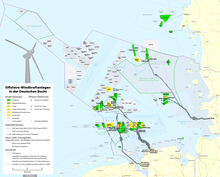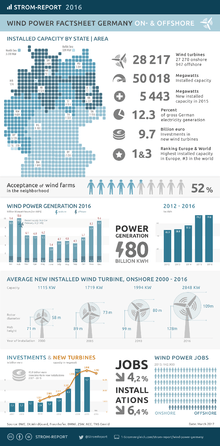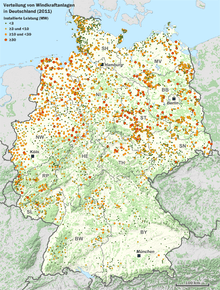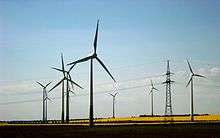Wind power in Germany
Wind power in Germany is a growing industry. The installed capacity was 55.6 gigawatt (GW) at the end of 2017, with 5.2 GW from offshore installations. In 2019, a quarter of the country's total electricity was generated using wind power,[2] compared to an estimated 9.3% in 2010.[3]
.jpg)
- Nuclear: 71.09 TWh (13.8%)
- Brown Coal: 102.18 TWh (19.9%)
- Hard Coal: 48.69 TWh (9.5%)
- Natural Gas: 54.05 TWh (10.5%)
- Wind: 127.22 TWh (24.8%)
- Solar: 46.54 TWh (9.1%)
- Biomass: 44.42 TWh (8.7%)
- Hydro: 19.23 TWh (3.7%)
More than 26,772 wind turbines were located in the German federal area by year end 2015, and the country has plans for further expansion.[4][5] As of the end of 2015 Germany was the third largest producer of wind power in the world by installations, behind China and the USA.[6] Germany also has a number of turbine manufacturers, like Enercon, Nordex and Senvion.
Onshore wind power
Since 1995, onshore wind energy has been an important and major industry in Germany. In 1995, the gross production of onshore wind power was 1,530 GWh. By 2019, gross production from onshore wind power was over 101,000 GWh, allowing Germany to power about a fifth of the country from wind.[7] Larger onshore installations are in the works, which could possibly see a larger percentage of wind energy powering Germany. Germany is also notable for having some major wind turbine manufacturers based there, such as Enercon in Aurich, Senvion in Hamburg, and Nordex in Rostock.
Offshore wind power

Offshore wind energy also has great potential in Germany.[8] Wind speed at sea is 70 to 100% higher than onshore and much more constant. A new generation of 5 MW or larger wind turbines which are capable of making full use of the potential of wind power at sea has already been developed and prototypes are available. This makes it possible to operate offshore wind farms in a cost-effective way once the usual initial difficulties of new technologies have been overcome.[9]
On 15 July 2009, the first offshore German windturbine completed construction. This turbine is the first of a total of 12 wind turbines for the alpha ventus offshore wind farm in the North Sea.[10]
Following the 2011 Japanese nuclear accidents, Germany's federal government is working on a new plan for increasing renewable energy commercialization, with a particular focus on offshore wind farms.[11] Under the plan, large wind turbines will be erected far away from the coastlines, where the wind blows more consistently than it does on land, and where the enormous turbines won't bother the inhabitants. The plan aims to decrease Germany's dependence on energy derived from coal and nuclear power plants.[12] The German government wants to see 7.6 GW installed by 2020 and as much as 26 GW by 2030.[13]
A major challenge will be the lack of sufficient network capacities for transmitting the power generated in the North Sea to the large industrial consumers in southern Germany.[14]
In 2014, all in all 410 turbines with 1747 megawatts were added to Germany's offshore windparks. Due to not yet finished grid-connections, only turbines with combined 528.9 megawatts were added to the grid feed at the end of 2014. Despite this, the gigawatt offshore windpower barrier was reportedly breached by Germany around the end of 2014[15] During 2015 offshore windpower was tripled to over 3 gigawatts capacity, signalling the growing importance of this sector.[16]
Government support
Since 2011, Germany's federal government has been working on a new plan for increasing renewable energy commercialization,[17] with a particular focus on offshore wind farms.[12]
In 2016, Germany decided to replace feed-in tariffs with auctions from 2017, citing the mature nature of the windpower market being best served in this way.[18]
Energy transition
The 2010 "Energiewende" policy has been embraced by the German federal government and has resulted in a huge expansion of renewables, particularly wind power. Germany's share of renewables has increased from around 5% in 1999 to 17% in 2010, reaching close to the OECD average of 18% usage of renewables.[19] Producers have been guaranteed a fixed feed-in tariff for 20 years, guaranteeing a fixed income. Energy co-operatives have been created, and efforts were made to decentralize control and profits. The large energy companies have a disproportionately small share of the renewables market. Nuclear power plants were closed, and the existing 9 plants will close earlier than necessary, in 2022.
The reduction of reliance on nuclear plants has so far had the consequence of increased reliance on fossil fuels and on electricity imports from France. However, in good wind Germany exports to France; in January 2015 the average price was €29/MWh in Germany, and €39/MWh in France.[20] One factor that has inhibited efficient employment of new renewable energy has been the lack of an accompanying investment in power infrastructure (SüdLink) to bring the power to market.[19][21] The transmission constraint sometimes causes Germany to pay Danish wind power to stop producing; in October/November 2015 this amounted to 96 GWh costing 1.8 million euros.[22]
The German states have varying attitudes to the construction of new power lines. Industry has had their rates frozen and so the increased costs of the Energiewende have been passed on to consumers, who have had rising electricity bills. Germans in 2013 had some of the highest electricity costs in Europe.[23]
Public opinion

Wind power has had very high social acceptance in Germany since 2008.[24]
In Germany, hundreds of thousands of people have invested in citizens' wind farms across the country and thousands of small and medium-sized enterprises are running successful businesses in a new sector that in 2015 employed 142,900 people and generated 12.3 percent of Germany's electricity in 2016.[25]
However, more recently, there has been increasing local resistance to the expansion of wind power in Germany, due to its impact on the landscape, incidences of removal of forests to build wind turbines, the emission of low frequency noise,[26][27] and the negative impact on wildlife, such as birds of prey and bats.[28][29]
Repowering
Repowering, the replacement of first-generation wind turbines with modern multi-megawatt machines, is occurring in Germany. Modern turbines make better use of available wind energy and so more wind power can come from the same area of land. Modern turbines also offer much better grid integration since they use a connection method similar to conventional power plants.[30][31]
Statistics

Installed wind power capacity and generation in recent years is shown in the table below:
| Year | 1990 | 1991 | 1992 | 1993 | 1994 | 1995 | 1996 | 1997 | 1998 | 1999 |
|---|---|---|---|---|---|---|---|---|---|---|
| Installed Capacity (MW) | 55 | 106 | 174 | 326 | 618 | 1,121 | 1,549 | 2,089 | 2,877 | 4,435 |
| Generation (GW·h) | 71 | 100 | 275 | 600 | 909 | 1,500 | 2,032 | 2,966 | 4,489 | 5,528 |
| Capacity factor | 14.74% | 10.77% | 18.04% | 21.01% | 16.79% | 15.28% | 14.98% | 16.21% | 17.81% | 14.23% |
| Year | 2000 | 2001 | 2002 | 2003 | 2004 | 2005 | 2006 | 2007 | 2008 | 2009 |
| Installed Capacity (MW) | 6,097 | 8,738 | 11,976 | 14,381 | 16,419 | 18,248 | 20,474 | 22,116 | 22,794 | 25,732 |
| Generation (GW·h) | 9,513 | 10,509 | 15,786 | 18,713 | 25,509 | 27,229 | 30,710 | 39,713 | 40,574 | 38,648 |
| Capacity Factor | 17.81% | 13.73% | 15.05% | 14.64% | 17.53% | 16.92% | 17.04% | 20.44% | 19.45% | 17.19% |
| Year | 2010 | 2011 | 2012 | 2013 | 2014 | 2015 | 2016 | 2017[32] | 2018[33] | 2019[34] |
| Installed Capacity (MW) | 26,903 | 28,712 | 30,979 | 33,477 | 38,614 | 44,541 | 49,534 | 55,550 | 59,420 | 61,357 |
| Generation (GW·h) | 37,795 | 48,891 | 50,681 | 51,721 | 57,379 | 79,206 | 77,412 | 103,650 | 111,410 | 127,230 |
| Capacity Factor | 16.04% | 19.44% | 18.68% | 17.75% | 17.07% | 20.43% | 17.95% | 21.30% | 21.40% | |
| Year | 2009 | 2010 | 2011 | 2012 | 2013 | 2014 | 2015 | 2016 | 2017 | 2018 |
|---|---|---|---|---|---|---|---|---|---|---|
| Installed Capacity (MW) | 30 | 80 | 188 | 268 | 622 | 994 | 3,297 | 4,150 | 5,260 | |
| Generation (GW·h) | 38 | 176 | 577 | 732 | 918 | 1,471 | 8,284 | 12,365 | 17,420[35] | 19,070[35] |
| % of Wind Gen. | 0.1 | 0.5 | 1.2 | 1.4 | 1.8 | 2.6 | 10.5 | 16.0 | 16.8 | |
| Capacity Factor | 14.46% | 25.11% | 35.04% | 31.18% | 16.85% | 19.94% | 28.68% | 34.01% | 37.81% |
States

| State | No. Turbines | Installed Capacity [MW] | Share in the net electrical energy consumption [% in 2011] |
|---|---|---|---|
| 2,861 | 5,121 | 48.11 | |
| 3,791 | 6,983 | 47.65 | |
| 3,653 | 6,894 | 46.46 | |
| 1,911 | 3,325 | 46.09 | |
| 6,277 | 10,981 | 24.95 | |
| 863 | 1,573 | 12.0 | |
| 1,739 | 3,553 | 9.4 | |
| 892 | 1,205 | 8.0 | |
| 91 | 198 | 4.7 | |
| 3,708 | 5,703 | 3.9 | |
| 1,141 | 2,144 | 2.8 | |
| 198 | 449 | 2.5 | |
| 1,159 | 2,510 | 1.3 | |
| 719 | 1,507 | 0.9 | |
| 63 | 123 | 0.7 | |
| 5 | 12 | 0.0 | |
| offshore North Sea | 997 | 4,695 | |
| offshore Baltic Sea | 172 | 692 | |
| Germany Total | 30,240 | 57669 | 17,6 |
See also
- Renewable energy in Germany
- Solar power in Germany
- Geothermal power in Germany
- Wind power in the European Union
- Renewable energy by country
References
- Burger, Bruno (15 January 2020). Public Net Electricity Generation in Germany 2019 (pdf). ise.fraunhofer.de. Freiburg, Germany: Fraunhofer Institute for Solar Energy Systems ISE. Retrieved 2 February 2020.
- "Nettostromerzeugung in Deutschland in 2019". Fraunhofer Institut für Solare Energiesysteme. Retrieved 14 January 2020.
- Wind in power 2010 European statistics EWEA February 2011, page 11
- "Wind energy in Germany".
- "GERMANY: WIND POWER FACTSHEET 2016". Strom-Report.
- "Global-Wind-2015-Report, GWEC p9, p10" (PDF).
- "Time series for the development of renewable energy sources in Germany" (PDF). Informationsportal Erneuerbare Energien. Retrieved 17 April 2020.
- Rehfeldt, Dr. Knud (January 2007). "Offshore wind power deployment in Germany" (PDF). Federal Ministry for Environment, Nature Conservation and Nuclear Safety. Retrieved 4 June 2011.
- Kuhbier, Jörg (22 February 2007). "Offshore Wind Power in Germany" (PDF). Federal Ministry for Environment, Nature Conservation and Nuclear Safety. Retrieved 21 June 2007.
- Alpha Ventus
- Dohmen, Frank; Jung, Alexander (27 April 2011). "Why Germany's Offshore Wind Parks Have Stalled". Spiegel Online. Retrieved 1 January 2012.
- Schultz, Stefan (23 March 2011). "Will Nuke Phase-Out Make Offshore Farms Attractive?". Spiegel Online. Retrieved 26 March 2011.
- Dohmen, Frank; Jung, Alexander (30 December 2011). "Stress on the High Seas: Germany's Wind Power Revolution in the Doldrums". Spiegel Online. Retrieved 1 January 2012.
- The Wall Street Journal Online, 24 April 2012
- "Offshore Wind Energy in Germany 2014". Bundesverband WindEnergie e.V. Retrieved 30 January 2015.
- "Federal Ministry for Economic Affairs and Energy (Germarny),Zeitreihen zur Entwicklung der erneuerbaren Energien in Deutschland, Stand August 2016".
- "100% renewable electricity supply by 2050". Federal Ministry for Environment, Nature Conservation and Nuclear Safety. 26 January 2011. Retrieved 4 June 2011.
- Hill, Joshua S (2016-07-12). "Germany Confirms End To Renewable Energy Feed-in Tariffs". cleantechnica.com. Retrieved 2017-02-08.
- "Germany's energy transformation Energiewende". The Economist. Jul 28, 2012. Retrieved 6 March 2013.
- Click Green (3 February 2015). "UK and German wind energy records drive down winter electricity bills". clickgreen.org.uk.
- Knight, Sara (29 May 2015). "Politics block German offshore wind link". windpowermonthly.com. Archived from the original on 6 September 2015.
- Jesper Starn, Weixin Zha (1 December 2015). "Germany Pays to Halt Danish Wind Power to Protect Own Output". Bloomberg News.
- "Germany's energy reform Troubled turn". The Economist. 9 Feb 2013. Retrieved 6 March 2013.
- Community Wind Farms at the Wayback Machine (archived July 20, 2008)
- "Community Power Empowers". Dsc.discovery.com. 26 May 2009. Retrieved 17 January 2012.
- "Nach Vorwürfen – Wirsol geht in die Informationsoffensive".
- "Spagat zwischen Klimaschutz und Naturschutz". Deutschlandfunk. Deutschlandfunk. Retrieved 9 June 2019.
- Wang, Shifeng (April 2015). "Ecological impacts of wind farms on birds: Questions, hypotheses, and research needs". Renewable and Sustainable Energy Reviews. 44: 599–607. doi:10.1016/j.rser.2015.01.031.
- Voigt, Christian (April 2015). "Wildlife and renewable energy: German politics cross migratory bats". European Journal of Wildlife Research. 61 (2): 213–219. doi:10.1007/s10344-015-0903-y.
- Hochstätter, Matthias; Paulsen, Thorsten; Grotz, Claudia (May 2006). "A clean issue -- Wind energy in germany" (PDF). BWE-Bundesverband Windenergie. p. 18.
- Fairley, Peter (19 January 2009). "Europe Replaces Old Wind Farms". IEEE Spectrum. Retrieved 24 January 2009.
- "Electricity generation in Germany | Energy Charts". www.energy-charts.de. Fraunhofer ISE. Retrieved 18 January 2018.
- "Electricity generation in Germany | Energy Charts". www.energy-charts.de. Fraunhofer ISE. Retrieved 14 February 2019.
- "Electricity generation in Germany | Energy Charts". www.energy-charts.de. Fraunhofer ISE. Retrieved 13 June 2020.
- "Electricity generation in Germany | Energy Charts". www.energy-charts.de. Fraunhofer ISE. Retrieved 18 January 2018.
- "Status des Windenergieausbaus an Land in Deutschland, 1. Halbjahr 2018" [Status of wind energy in Germany 31.12.2011 DEWI] (PDF) (in German). Deutsche Windguard. Retrieved 15 August 2018.
External links
| Wikimedia Commons has media related to Wind power in Germany. |
- Germany Inaugurates 5 MW Wind Turbine Prototype
- 5-MW BARD Near-shore Wind Turbine Erected in Germany
- Deutsche Energie-Agentur (Dena), German Energy Agency
- Official site about wind power and renewable Energy in the Emscher-Lippe-Region
- Cost-optimal expansion of renewables would save Germany up to two billion euros a year


